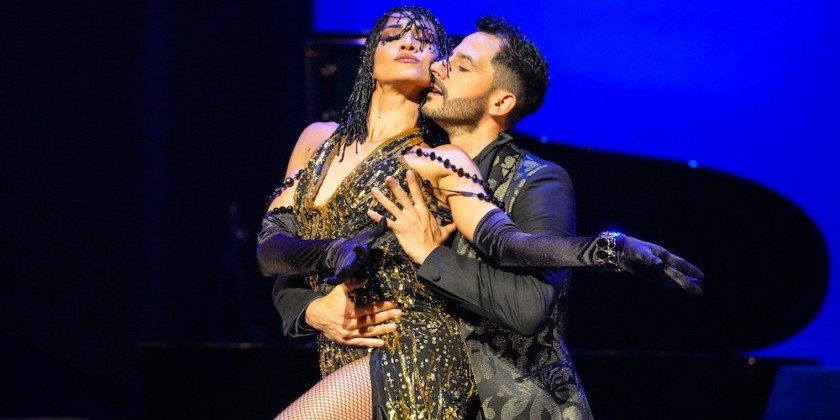AUDIENCE REVIEW: The Apocalyptic Body – Ballet Preljocaj’s “And then, one thousand years of peace” at BAM

Company:
Ballet Preljocaj
Performance Date:
November 8, 2013
Freeform Review:
And then, one thousand years of peace
Ballet Preljocaj
Performed Nov. 7-9, 2013
Howard Gilman Opera House, Brooklyn Academy of Music
Reviewed by Katherine Bergstrom
katherine.m.bergstrom@gmail.com
Heavy chains falling from the sky, costumes made from the flags of the world, and live sheep on the stage – how often does a dance work include all three? In Angelin Preljocaj’sAnd then, one thousand years of peace, performed this past weekend by the Provence-based Ballet Preljocaj as part of the Brooklyn Academy of Music’s Next Wave Festival, the eclectic mix of scenarios included these and many more. Although it’s tempting to make conjectures about what this all means for a piece loosely based around the idea of the Apocalypse, Preljocaj implores his viewers not to look for clichd images of destruction and the end of the world. Instead, his inspiration comes from a more literally meaning of the word “apocalypse” – the uncovering of hidden elements, taken from the Greek translation of the word that equates roughly to “to lift the veil.” Through a series of vignette-type sections,And then, one thousand years of peacetraverses a multitude of relationships and settings, using the dancing body as the interpreter of each of these strange worlds.
The piece opens with the company’s eleven women dancing fast, ballet-infused phrases, full of high legs and sudden drops to the floor. When the Laurent Garnier’s mildly abrasive house beat subsides, the women descend to the floor, and what appeared to be shadowy rectangles created by the lighting are suddenly recognized as sheets of clear plastic wrap when the women crawl underneath them. When the men enter the stage and lift their encapsulated partners, the image is both embryonic and suffocating, but also precarious in the way the men gently cradle their partners, responding to the glass-like fragility implied by the plastic casing.
From here, the piece picks up speed again, and this becomes a pattern throughout the work, as the dancing fluctuates between large groups and duets or trios, juxtaposing intense dance sequences with more gestural or task-based moments. Preljocaj is a gifted choreographer, even though there are moments throughout the piece that tend towards the “contemporary” shapes and dynamics we’ve seen before. But, working with the wild strength of the Ballet Preljocaj dancers, he’s made some truly beautiful sequences, one of which occurs when the electro-synth gives way to Beethoven’s “Moonlight Sonata,” and two women take the stage. Their dance is both lyrical and physical, responding to not only the music’s undulating arpeggio pattern, but to the striking bass notes of each chord as well. Their synchrony extends beyond matching rhythms; it’s as if their minds one in the same, with every glance, attack, and fall perfectly aligned.
Preljocaj’s apocalypse is primarily concerned with the dancer as the discloser of knowledge, and references to this end are spread throughout the piece. At one point, the dancers walk briskly across the stage with a book in each hand and another between their teeth, performing a dynamic series of gestures at different times and facing different directions. Here, they show that the knowledge they have to share to night cannot be learned from any text, but is fully and sufficiently contained within the present bodies (in later sequences, many of the books end up loosing some pages as casualties of the choreography, another indication that these books are not the prioritized containers of truth).
The premise of veiling and unveiling is also a recurring thread. Mid-way through the piece, the dancers enter the stage, blindfolded by their costumes – flags of the world tied about their bodies, covering their eyes. Yet, despite the hindrance, they still manage to arrange themselves into a series of sexualized poses. At the end of the piece, these same flags are laid out flat on the stage and revealing their distinguishing features. Here’s where the sheep come in: amidst this collage of nations, two dancers enter, each carrying a lamb in her arms. Once released, the lambs took a few moments to explore the stage together. Though Preljocaj has advised against reading religious symbolism into his work, it’s hard to deny that the appearance of lambs – the symbols of innocence and the benevolent Christ – upon a stage filled with flags of the world’s nations has any meaning, especially at the end of a work that shares its title with a phrase from the apocalyptic Book of Revelations (in which an angel binds Satan with a chain, preventing him from “deceiving the nations” for one thousand years). And yet, amidst these images, it must be remembered how they came to be collected: that is, through the truth of these dancing bodies. For those still searching for the “meaning” of Preljocaj’s work, perhaps the dancing itself is the unveiling of the answer, for no matter how eccentric the scenarios may seem, they are each fulfilled by nothing else but the sincere honesty of the moving body.
This review can also be read on my personal blog, Point of Contact.












